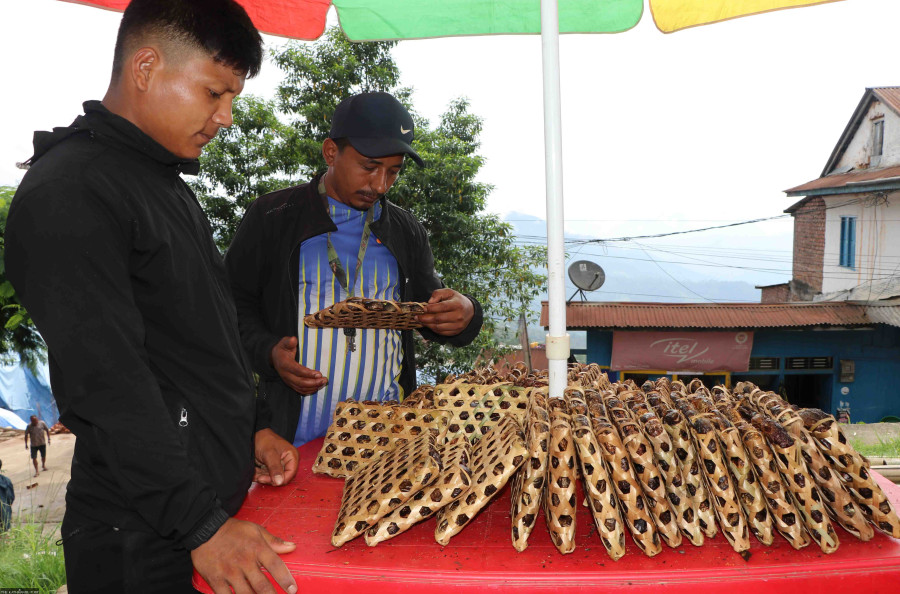Money
Destructive fishing pushing snowtrout towards extinction in Himalayan rivers
Use of electricity and explosives to catch fish in Sankhuwasabha has led to a decline of fish stocks.
Parbat Portel & Dipendra Shakya
Amar Rai of Sabha Pokhari Rural Municipality in Nepal’s eastern hills has been fishing for decades. He mostly catches snowtrout because it is in high demand and fetches a good price.
Snowtrout is a riverine cold-water fish belonging to the family Cyprinidae. It is commonly called Tikhe Asala in Nepal.
Of late, Rai has reason to be worried. “There aren’t fish in the Sabha River like before,” he moans.
Snowtrout had been an integral part of the local economy in Sankhuwasabha district.
The International Union for Conservation of Nature, an international organisation dedicated to the conservation of natural resources, has kept Tikhe Asala (Schizothoraichthys nepalensis) in its “red list” which means it is critically endangered.
Like Rai, hundreds of fishermen used to fish in the Sabha, Arun, Sankhuwa and Lankhuwa rivers that charge down from the Himalayan glaciers. They used to sell their catch to hotels and eateries on the highways. Dried snowtrout is the most sought after variety both in the domestic and international markets.
Locals say that fishermen in the hill district used to make a handsome income, bringing millions of rupees from the cities to their villages.
The residents have been earning their livelihoods from fishing for generations. But the good old days are no more. Because of haphazard fishing and fishing with electricity and explosives, there are no fish in the rivers.
“Many fishermen left traditional fishing and opted for fishing with electricity,” said Rai who still uses indigenous tools—hook and line.
Local fishermen admit that they previously used non-lethal tools such as fishing cords, nets and indigenous bamboo traps. These traditional methods prevented overfishing.
Catching fish is not inherently bad for the rivers. But when electric shocks and explosives are applied to catch fish faster, then stocks cannot replenish. It is called overfishing, according to experts. Such acts are a threat that cause the needless loss of fish along with other water creatures.
In rural Nepal, many people rely on fish for protein, and fishing is the principal livelihood for many.
Many people who make a living catching, selling and buying fish are focused on sustainable practices that not only conserve ecosystems, but also sustain livelihoods and ensure food security.
“But haphazard fishing has pushed the snowtrout to near extinction. This will impact the local economy,” said Bhim Bahadur Limbu, chairman of Sabha Pokhari Rural Municipality.
“Unscrupulous fishermen have resorted to destructive ways to kill a large quantity of fish with little effort,” said Limbu. “The rivers are now empty.”
According to a report of the Asian Development Bank, more than 6,000 rivers drain the country.
Nepal’s three major river basins—Koshi, Gandaki and Karnali—host about 230 species of freshwater fish and scores of zooplankton and phytoplankton, forming a rich and unique aquatic ecosystem.
The river provides habitats for a variety of fish species unique to those particular ecosystems.
Lakshmi Chapagain, deputy chief of Sabha Pokhari Rural Municipality admits fishermen have forgotten their responsibility.
“The fish in local rivers have decreased to the bare minimum,” she said. According to the local body, around one-third of the village depends on fishing for their livelihood.
Several reports show that overfishing can impact entire ecosystems. It can change the size of the remaining fish, as well as how they reproduce and the speed at which they mature.
Overfishing creates an imbalance that can erode the food web and lead to the loss of other important aquatic life.
In response to such reckless fishing, the local government has prepared plans and policies to protect the fish in the local rivers to save the ecology and create economic benefits for the villagers.
Last October, the local government passed a law to manage fishing and punish those who use electricity and explosives to catch fish.
The rural municipality has prohibited fishing on a kilometre-long stretch of the Sabha Khola from Saatbise to Langkhuwa Dobhan.
“This section will be developed as a conservation area to provide a safe breeding zone for snowtrout,” said Chapagain. “Anyone caught fishing in the prohibited zone will be fined Rs20,000,” she said.
The rural municipality is preparing to attract domestic and foreign tourists to the area by promoting snowtrout.
But villagers say that illegal fishing has not stopped. Some fishermen still use electricity during the night time.
“We are also trying to create awareness among locals about the potential impact of illegal fishing,” said Chapagain.
Sange Sherpa, a local fish trader, says demand for dried snowtrout is high everywhere. “We primarily sell them in the markets like Barhabise, Khandbari and Tumlingtar.”
Arun Bohora, a local hotel entrepreneur of Katle Bhanjyang, says that fresh snowtrout fetches up to Rs2,000 per kg. Dried snowtrout fetches Rs10,000 per kg in the local market.
Bohora says he sells more than 15 kg of fresh snowtrout at his hotel daily.
There are more than a dozen hotels in Tumlingtar, the district headquarters.
“The fish are abundant during the winter and their number declines during the rainy season,” added Bohora.
According to experts, snowtrout can survive only in fresh and cold water. Therefore, they are hard to find during the rainy season.
Snowtrout do not like lacustrine conditions and cannot survive well in reservoirs. They inhabit flowing water and prefer fast-flowing water over a gravel bottom for spawning.
This helps fertilisation and completion of the larval life cycle of the species. In stagnant water, the eggs sink to the bottom and the larvae cannot swim to the surface for the completion of the larval life span.
Snowtrout is found from mid-November to mid-March, which is the key fishing season.




 10.12°C Kathmandu
10.12°C Kathmandu














